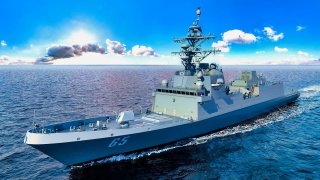The Navy's Constellation-Class Frigate Has Just 1 Important Mission
Designed to counter China's expanding naval power, these ships will perform various roles, including anti-surface, anti-submarine, convoy defense, and enhancing fleet tactical awareness. The Navy aims to procure 20 vessels at a cost between $850 million and $950 million each.
Summary and Top Points You Need to Know: The U.S. Navy's next guided-missile destroyer, the Constellation-class, is set to debut in 2026. Derived from the European FREMM frigate, the Constellation-class will bolster the Navy’s fleet, aiming to counter China's growing naval power in the Indo-Pacific.
-The Navy plans to procure 20 vessels, each costing around $850 million to $950 million, to fulfill roles such as anti-surface and anti-submarine warfare, convoy defense, and enhanced fleet tactical awareness.
-The Constellation-class will integrate into strike groups, supporting U.S. supercarriers with advanced sensors and combat capabilities.
U.S. Navy Prepares for China with Advanced Constellation-Class Warships
The U.S. Navy’s next guided-missile destroyer class is under construction. The Constellation class is a derivative of the European FREMM (European multi-purpose frigate), and it should debut in the next few years. The Navy hopes to procure 20 Constellation vessels to bolster the fleet against the prospect of conflict with China.
The new vessel will fulfill a variety of roles, including anti-surface, anti-submarine, convoy defense, and enhanced fleet tactical awareness.
The impetus for building the Constellation is clearly China’s aggressive naval expansion and its territorial claims in the Indo-Pacific region. The U.S. hopes to field a naval force capable of deterring the Chinese and countering them if necessary. It needs to maintain a strong influence in the strategically vital Indo-Pacific region.
The Constellation Bid
The Navy announced the FFG(X) frigate project in July 2017 with a Department of Defense Request for Information (RFI).
The FFG(X) was billed as a program for a new guided-missile frigate, and the contract would be lucrative. Five shipbuilding companies offered bids for the program.
The Navy selected the winner, Fincantieri Marinette Marine, in April 2020. The winning design was simply a modified version of the European FREMM, which is currently sailing in the French and Italian navies. Once the bid was assigned, the Department of Defense redesignated the FFG(X) program as FFG-62 after the leading ship in the class.
The Navy’s budget proposal for the class suggests that each ship will cost between $850 million and $950 million.
The Constellation-Class Design
The Navy pressed for the Constellation to be designed and fielded on an accelerated timeline, meaning the designers did not have time to create a ship from scratch. That is why the shipbuilders worked from an existing design.
As the original RFI noted: “Competition for FFG(X) is envisioned to consider existing parent designs for a Small Surface Combatant that can be modified to accommodate the specific capability requirements prescribed by the U.S. Navy,”
The RFI was less specific about what the ship should be able to do, but the requirement that the FFG(X) be derivative of an existing ship was made quite clear. The FREMM served the purpose.
We can surmise what the Constellation will be used for by considering the ship that provided her inspiration. We can reasonably expect the Constellation will be used to target enemy surface vessels, detect enemy submarines, defend friendly convoys, employ active and passive electronic warfare systems, and defend against swarming small boat attacks.
We also know that the Navy needed a surface vessel that could keep up with the speed of the U.S. supercarriers and provide support. Additionally, the service needed a vessel that had the sensory capabilities to allow the entire fleet to function with enhanced and expanded tactical awareness.
“The FFG(X) will normally aggregate into strike groups and Large Surface Combatant led surface action groups but also possess the ability to robustly defend itself during conduct of independent operations while connected and contributing to the fleet tactical grid,” David Larter reported.
In other words, the Navy needs a boat that can keep up in a war against China.
About the Author: Harrison Kass
Harrison Kass is a defense and national security writer with over 1,000 total pieces on issues involving global affairs. An attorney, pilot, guitarist, and minor pro hockey player, Harrison joined the US Air Force as a Pilot Trainee but was medically discharged. Harrison holds a BA from Lake Forest College, a JD from the University of Oregon, and an MA from New York University. Harrison listens to Dokken.
All images are Creative Commons.


